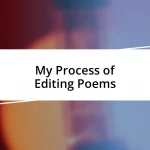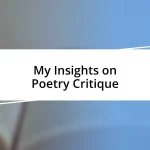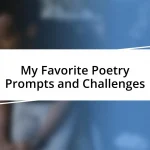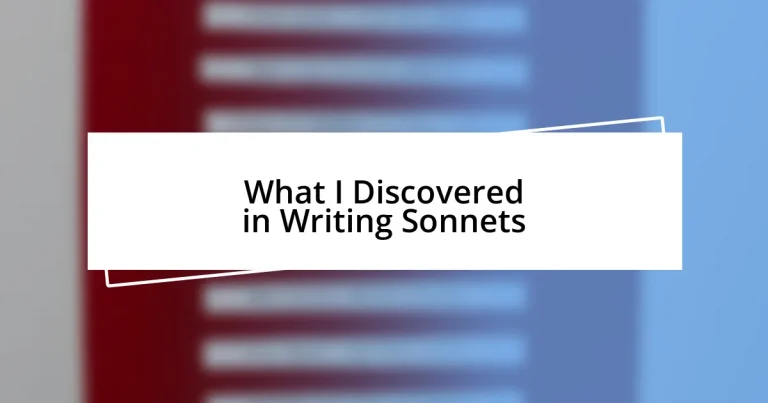Key takeaways:
- The sonnet form, with its structure and rhyme schemes, allows for profound emotional expression and encourages introspection.
- Different sonnet types (Shakespearean, Petrarchan, Spenserian, and Modern) offer unique challenges that shape poetic themes and emotional arcs.
- Techniques like iambic pentameter, strong imagery, and reading others’ work are essential for developing a distinctive poetic voice.
- Revising sonnets through distance, rhythm attention, and feedback is crucial for enhancing quality and deepening connections with the poetry community.
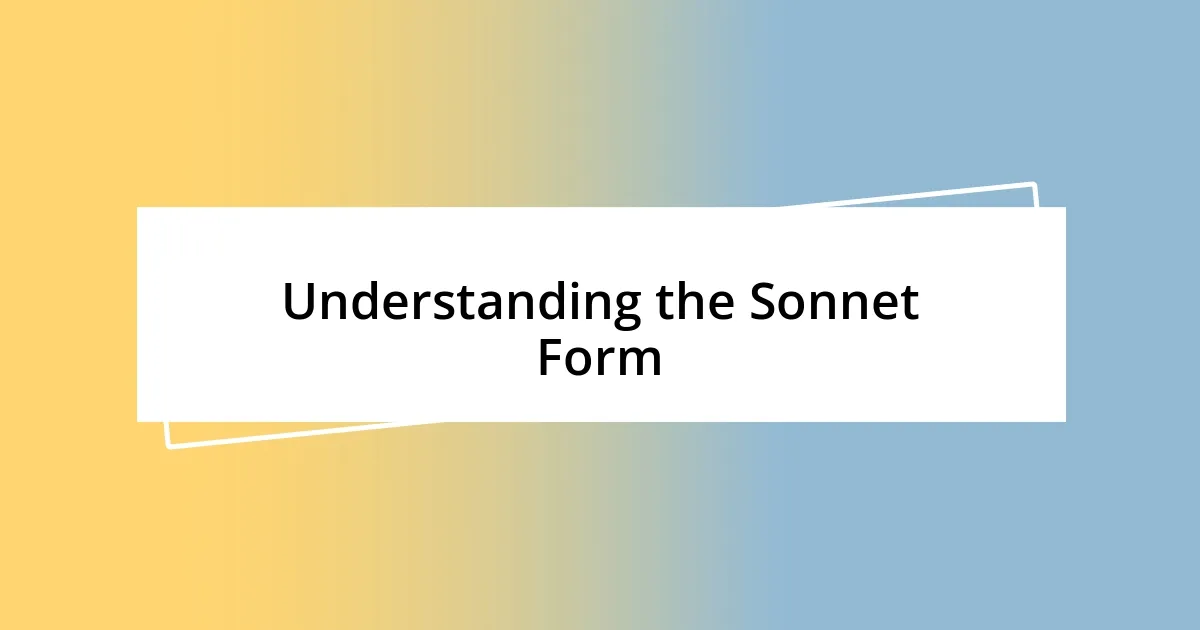
Understanding the Sonnet Form
When I first encountered the sonnet form, I was struck by its elegance and structure—fourteen lines neatly divided into specific rhyme schemes and rhythms. I remember wrestling with the iambic pentameter, feeling both restricted and liberated. Isn’t it fascinating how such a strict form can yield some of the most profound expressions of love and beauty?
As I immersed myself in writing sonnets, I realized that each line was a puzzle piece, fitting together to create a cohesive emotional narrative. The volta, or turn, in the poem often provided a moment of revelation for me, shifting the entire mood or perspective. Have you ever felt that moment when everything suddenly makes sense in your writing?
Exploring the themes common in sonnets, like love, loss, and nature, opened up new avenues of self-expression for me. There’s a unique joy in capturing a complex emotion within the confines of just fourteen lines—like trying to catch a butterfly in a jar. What’s your experience with distilling your thoughts into such a compact format?
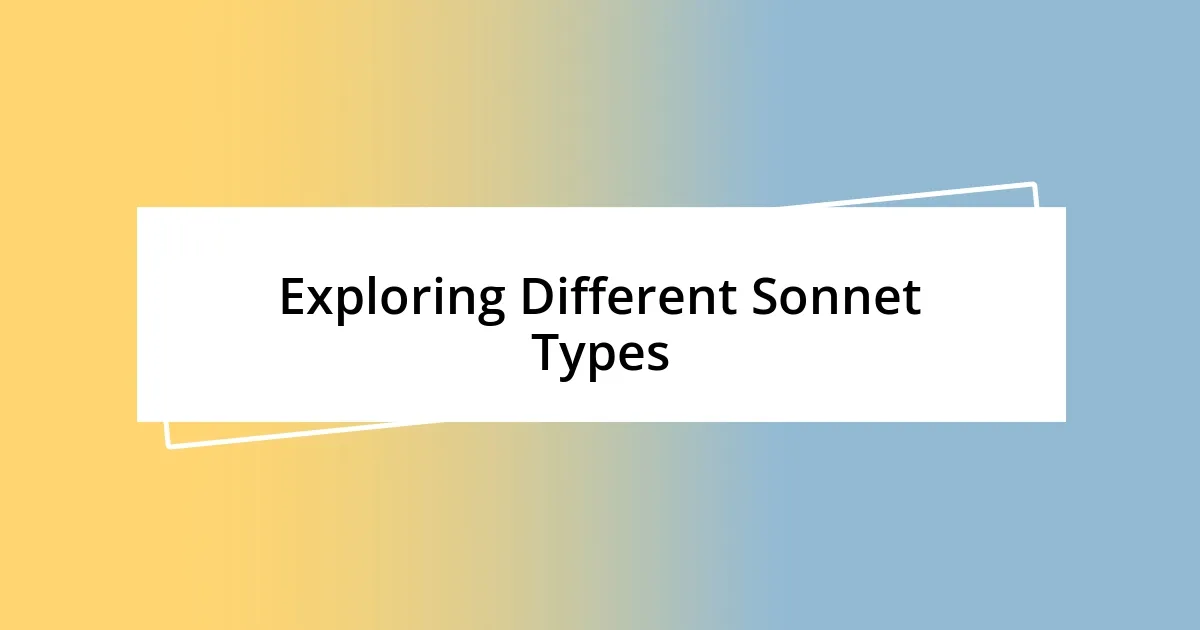
Exploring Different Sonnet Types
Diving into the different types of sonnets has been a rich experience for me. Each variation brings its own flavor and specific rules, offering new challenges and insights. I’ve found myself particularly drawn to the Shakespearean sonnet, with its ABABCDCDEFEFGG rhyme scheme. The way it culminates in a memorable couplet often leaves me pondering the broader implications of the preceding lines.
Here are some sonnet types I explored:
- Shakespearean (or English) Sonnet: Consists of three quatrains and a final couplet.
- Petrarchan (or Italian) Sonnet: Features an octave and a sestet, usually following the ABBAABBA rhyme scheme.
- Spenserian Sonnet: Similar to the Shakespearean but with an interlocking rhyme scheme (ABABBCBCCDCDEE).
- Modern Sonnet: This variant allows for more flexibility with rhyme and structure, giving poets creative freedom.
Engaging with each sonnet type revealed how flexibility in their structure shapes the themes I could explore. I recall vividly sitting down to write my first Petrarchan sonnet, feeling a sense of liberation with the octave’s ability to pose a problem, leading to an unexpected resolution in the sestet. It forced me to think critically about the emotional arc of my writing, igniting a new level of introspection that enhanced my poetic voice.
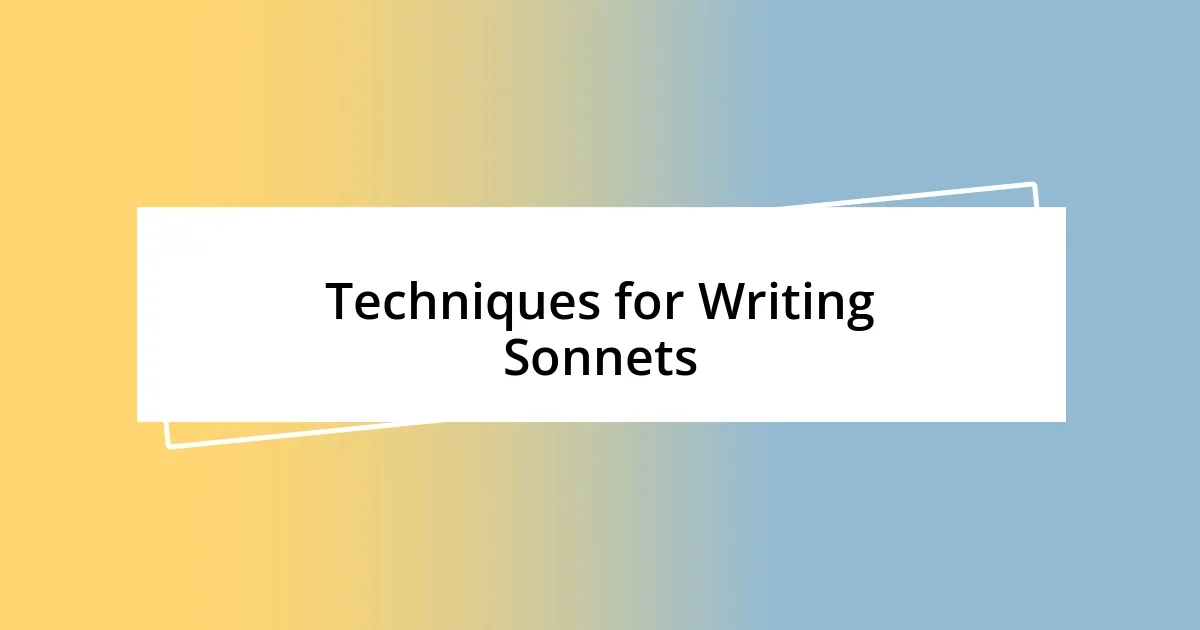
Techniques for Writing Sonnets
When I began to explore techniques for writing sonnets, I quickly realized the importance of meter, particularly iambic pentameter. There’s something surprisingly satisfying about the rhythm—the alternating unstressed and stressed syllables give the lines a musical quality. I often found myself humming the verses as I wrote, which helped the words flow more naturally. Have you ever noticed how the rhythm can set the mood for your entire poem?
Another technique I’ve embraced is the use of strong imagery and metaphors. Crafting vivid images within the constraints of fourteen lines can feel like painting with a limited palette. I remember writing a sonnet that painted a sunset using only colors and emotions, and it felt like I was capturing a fleeting moment in time. Isn’t it exhilarating to encapsulate such beauty in a few succinct words?
Lastly, I found that reading classic and contemporary sonnets profoundly influenced my own writing style. It’s like having a conversation with the masters; their choices in wordplay and structure have inspired me to experiment and push my boundaries. I once spent a weekend revising a sonnet based on what I learned from Elizabeth Barrett Browning, and it transformed my approach entirely, making me bolder in my poetic voice.
| Technique | Description |
|---|---|
| Iambic Pentameter | A rhythmic pattern that creates a musical flow, consisting of five pairs of unstressed and stressed syllables. |
| Imagery and Metaphor | Using vivid images and comparisons to evoke emotions and pictures in the reader’s mind. |
| Reading Others’ Work | Engaging with various sonnets to inspire and refine one’s own writing style and techniques. |

Thematic Elements in Sonnets
Thematic elements in sonnets often reflect universal human experiences such as love, time, beauty, and mortality. I remember writing a Shakespearean sonnet focused on the bittersweet nature of love. As I explored the theme, I felt the tension between longing and acceptance, illuminating the often-contradictory emotions we face. Isn’t it fascinating how a few carefully chosen words can encapsulate such complex feelings?
One theme I find particularly compelling is the passage of time. In my own writing, I’ve tackled how fleeting moments shape our identities. I once penned a sonnet about the changing seasons, using nature’s cycle to mirror personal growth. With each line, I felt transported through my own experiences, illustrating how time can both heal and haunt us. Have you ever captured a moment in writing that made you reflect on your own journey?
Imagery also plays a crucial role in conveying themes within sonnets. During one writing session, I experimented with the theme of beauty and decay. I recalled an overgrown garden I’d seen—lush yet crumbling—which inspired vivid images that juxtaposed life and death. This exploration deepened my appreciation for how contrasting themes can coexist and enrich the meaning of a sonnet. How do you visualize complex themes in your writing?

Revising and Refining Your Sonnet
When it comes to revising a sonnet, I find that stepping back to gain some distance is invaluable. After completing a draft, I often leave it overnight, allowing fresh eyes to spot awkward phrases or forced rhymes when I come back. I remember one sonnet where I initially felt proud of my word choices, only to realize upon rereading that I’d stumbled into clichés that dulled the impact. Have you ever had that moment of clarity when you saw your writing anew?
As I dive into the revision process, I turn my attention to each line’s rhythm and flow. Sometimes, shifting a single word can enhance the musicality of the verse and create a more powerful emotional response. I once struggled with a couplet that felt flat until I decided to swap out just one word—it was as if the entire stanza breathed new life. Do you take the time to play with your words, or do you stick to a more straightforward revision approach?
Feedback from others also plays a critical role in refining my sonnet. Engaging with fellow poets can open up perspectives I may have missed. I vividly recall a workshop where critiques transformed a sonnet I thought was polished into something far richer and more layered. How do the insights of others influence your writing journey? Embracing constructive criticism has not only made my sonnets better but deepened my connection to the poetry community as well.

Sharing and Analyzing Your Sonnets
Sharing your sonnets can be both exhilarating and terrifying. I remember the first time I read my work aloud at a local open mic. My heart raced as I listened to the audience’s reactions, which ranged from nods of understanding to thoughtful silence. Did their responses resonate with what I had felt while writing? The thrill of sharing your thoughts and finding connections with listeners can be a rewarding experience that makes the solitary act of writing feel communal.
When it comes to analyzing your sonnets, I often find that revisiting them with a critical eye reveals layers I hadn’t noticed before. After attending a poetry circle, I went home and reread a piece I had been initially proud of. To my surprise, I discovered a repeated metaphor I hadn’t consciously realized I was using. This process gave me deeper insights into what I was trying to convey. Have you ever had a moment where a second reading transformed your understanding of your own writing?
Discussing sonnets with others can illuminate aspects of your work you might never uncover alone. Once, a fellow poet pointed out the subtle alliteration I’d woven throughout a piece, enhancing its musical quality. I hadn’t even recognized it at first! This conversation helped me appreciate the importance of intricate details in my writing, showing how collaboration fosters growth. How do you engage with others to uncover hidden gems in your own poetry?







